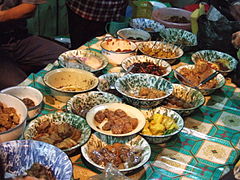 Nasi jamblang and side dishes | |
| Alternative names | Sega jamblang (Cirebonese or Javanese) |
|---|---|
| Course | Main course |
| Place of origin | Indonesia |
| Region or state | West Java |
| Created by | Cirebonese |
| Serving temperature | hot or room temperature |
Nasi jamblang is a typical food of Cirebon, West Java. The "jamblang" term comes from the name of the region to the west of the city of Cirebon, where food vendors first sold the dish. A characteristic feature of the dish is the use of teak leaves to pack the rice. The dish is served buffet-style.[1][2][3]
History[edit]
Nasi jamblang is a traditional Cirebonese food originally served to the forced labourers who built the Great Post Road from Anyer to Panarukan which passes through Cirebon Regency during the Dutch colonial era.[citation needed]
Menu[edit]
Dishes available usually include chili fries, tofu, vegetables, lung/liver/meat stews, satay, potatoes, fried scrambled eggs, stewed chili fish, salted fish, and tempeh. 6°43′0″S 108°34′0″E / 6.71667°S 108.56667°E
See also[edit]
References[edit]
- ^ Adhitya, Bagus Githa; P. Supriadi, R. Anggi; Ramadhani, Iqlima; Audita, Vanda Nirma; Andrianto, Ronal (2019). "Cirebon Culinary Travel Pattern:". Proceedings of the 1st NHI Tourism Forum. Bandung, Indonesia: SCITEPRESS - Science and Technology Publications: 76. doi:10.5220/0009516800720078. ISBN 978-989-758-495-4.
- ^ Rahmanita, Myrza; Suprina, Rina; Puarag, H. Peri (2017). "Culinary Tourism Phenomenon in Cirebon" (PDF). Advances in Economics, Business and Management Research. 28. Atlantis Press: 115–117.
- ^ "Berburu Kuliner Legendaris 4 Nasi Jamblang Khas Cirebon". suara.com (in Indonesian). 2019-04-18. Retrieved 2021-09-27.
Well, that’s interesting to know that Psilotum nudum are known as whisk ferns. Psilotum nudum is the commoner species of the two. While the P. flaccidum is a rare species and is found in the tropical islands. Both the species are usually epiphytic in habit and grow upon tree ferns. These species may also be terrestrial and grow in humus or in the crevices of the rocks.
View the detailed Guide of Psilotum nudum: Detailed Study Of Psilotum Nudum (Whisk Fern), Classification, Anatomy, Reproduction